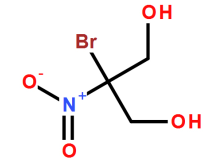Pesticide Sterilization Bronopol Fungicide 99% White Crystalline Powder
| Place of Origin: | WEIFANG,CHINA |
| Brand Name: | ZHAOYU |
| Certification: | ISO 9001; ISO 45001; ISO 14001 |
| Model Number: | 99.0% |
| Minimum Order Quantity: | 500 kgs |
| Price: | Negotiatable |
| Packaging Details: | 25kg Cardboard barrel; 500kg Container bag |
| Delivery Time: | 15 work days |
| Supply Ability: | 2000 Tons/Year |
|
Detail Information |
|||
| Place of Origin | WEIFANG,CHINA | Brand Name | ZHAOYU |
|---|---|---|---|
| Certification | ISO 9001; ISO 45001; ISO 14001 | Model Number | 99.0% |
| Another Name:: | Bronopol、BNPD | Chemical Name:: | 2-Bromo-2-Nitro-1,3-Propanediol |
| Molecular Formula:: | C3H6BrNO4 | Molecular Weight:: | 199.988 |
| CAS NO.:: | 52-51-7 | Einecs NO.:: | 200-143-0 |
| Content:: | 99.0% Min | Moisture:: | 0.5% Max |
| Appearance:: | White To Light Yellow Crystalline Powder | Melting Point:: | 129-132℃ |
| Stability:: | Slightly Hygroscopic | Highlight: | Broad Spectrum Fungicide CAS 52-51-7,Crystalline Broad Spectrum Fungicide,Bronopol Pesticide Crystalline |
Product Description
Pesticide Sterilization Bronopol Fungicide 99% White Crystalline Powder
Physical and chemical properties: The content of pure product is 99% (the content of aldehyde is 30%), and the appearance is white to light yellow powder or crystal. The melting point is 130°C. Vapor pressure (20°C) 1.68mPa. Solubility: water 250g/L (22°C); ethanol 500g/L, isopropanol 250g/L, propylene glycol 143g/L, glycerin 10g/L, liquid paraffin <5g/L (23~24°C). Stability: slightly hygroscopic.
Mechanism of antibacterial and antifungal effect: Bronopol has bactericidal effect through different chemical reaction mechanisms in aerobic and anaerobic atmospheres. In an aerobic atmosphere, bronopol catalyzes the oxidation of cysteine amino acids to cystine residues (Shepher et al., 1988). This mechanism is thought to act to kill microorganisms through the formation of reactive oxygen species such as superoxide or peroxide. Moreover, the formed cystine residues are attached to the cell wall, preventing the normal formation of the cell wall. The formation of reactive oxygen species and the cross-linking of cystine residues with the cell wall jointly lead to cell death. In an oxygen-free environment, the mechanism is that cells and extracellular nucleophiles attack the No. 2 carbon atom in the bronopol molecule.
The compound has good bactericidal and antibacterial effects on Gram-positive bacteria, Gram-negative bacteria, molds and yeasts, and is particularly effective on Pseudomonas aeruginosa.
2-Bromo-2-Nitro-1,3-Propanediol (Bronopol)

| Product Name | 2-Bromo-2-Nitro-1,3-Propanediol (Bronopol) |
| Molecular Formula | C3H6BrNO4 |
| Molecular Weight | 199.988 |
| CAS NO. | 52-51-7 |
| Appearance | White to light yellow crystalline powder |
| Content | 99.0% min |
| Melting Point | 129-132℃ |
| Moisture | 0.5% max |
The minimum inhibitory concentration (MIC) of bronopol to some microorganisms
| Microorganism | MIC/(mg/L) | Microorganism | MIC/(mg/L) |
|
Staphylococcus aureus NCIB 9518 |
25 |
Staphylococcus epidermidis NCTC 7291 |
25 |
|
Streptococcus faecalis NCTC 8213 |
25 |
Escherichia coli NCIB 9517 |
25 |
|
Klebsiella obstetrics NCTC 418 |
25 |
Proteus vulgaris NCTC 4635 |
25 |
|
Pseudomonas aeruginosa NCTC 6750 |
25 |
Pseudomonas fluorescens NCIB 9046 |
25 |
|
Salmonella typhimurium NCTC 74 |
12.5 |
Desulfovibrio NCIB 8301 |
12.5 |
|
Candida albicans ATCC 10231 |
1600 |
Saccharomyces cerevisiae NCYC 87 |
3200 |
|
Chaetomium globosa IMI 45550 |
800 |
Aspergillus niger ATCC 16404 |
3200 |
| Trichoderma viride | 6400 |




